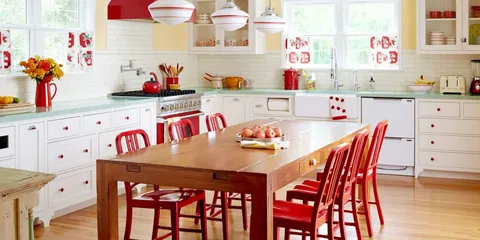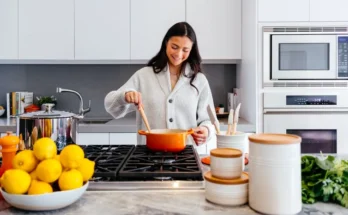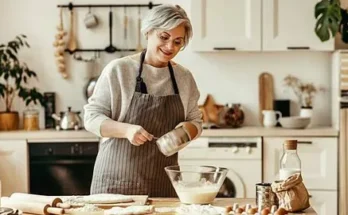Step into any home, and chances are, the heartbeat of the place isn’t the living room or the bedroom—it’s the kitchen. The kitchen is where life simmers and stories unfold. It’s where morning rituals are brewed into coffee mugs, where laughter is stirred into bubbling pots, and where burnt toast sometimes means you’re just human, not a chef.
The kitchen isn’t merely a place to cook. It’s a haven of expression, a canvas of culture, and the setting of countless family memories. No matter how big or small, glossy or rustic, every kitchen has a story—and most of those stories begin with a flicker of heat and a dash of curiosity.
A History Cooked in Time:
Long before quartz countertops and touchless faucets, the kitchen was little more than a fire pit. Early civilizations cooked over open flames, with food preparation happening in communal spaces. As societies evolved, the kitchen moved indoors and became more private—first out of necessity, then out of design.
In the Victorian era, kitchens were hidden away, seen as the domain of servants or the less glamorous side of domestic life. Fast forward to the 20th century, and the kitchen became central again. Innovations like the gas stove, refrigerator, and eventually the microwave revolutionized the way we cooked, while television and advertising rebranded cooking as both a chore and an art.
Today, the kitchen is once again evolving. It’s open-plan, connected, and increasingly tech-savvy. Smart ovens, voice-controlled appliances, and recipe apps make the kitchen feel like something out of a sci-fi novel. But underneath the stainless steel and screen displays, the core remains unchanged—it’s still the place where raw ingredients turn into nourishment, both physical and emotional.
The Kitchen as a Creative Playground:
-
The Art of Cooking, Beyond the Recipe
Some people follow recipes like sacred scripture. Others treat them more like a suggestion. But no matter how you approach it, cooking is inherently creative. It invites experimentation, improvisation, and a bit of boldness. You might start out aiming for spaghetti Bolognese and end up inventing your own fusion masterpiece.
A kitchen is where you can turn five random ingredients into dinner, or where a childhood favorite is reinvented with a twist of spice and imagination. Every time you cook, you’re not just feeding yourself or your family—you’re telling a story with flavor, texture, and timing.
Creativity in the kitchen isn’t about gourmet meals or perfect plating. It’s about trying, failing, tasting, and learning. It’s the courage to bake bread from scratch or throw together a meal from what’s left in the fridge. The best part? There are no rules—just your senses guiding you.
-
The Rise of Home Chefs and Kitchen Confidence
With the boom of cooking shows, online tutorials, and social media, the kitchen has become a stage where home chefs can shine. Platforms like YouTube and TikTok are filled with quick recipes, hacks, and culinary adventures that make cooking accessible to all.
This democratization of food culture has sparked a resurgence of kitchen confidence. People are not just cooking more—they’re enjoying it. The kitchen has shifted from a place of obligation to a space of self-expression.
The Emotional Language of Food:
-
Meals as Memory Keepers
Food is one of the strongest triggers of memory. A single bite of your grandmother’s stew or a whiff of a dish you ate on vacation can transport you across years and miles. And those memories are often rooted in the kitchen—the scent of spices wafting through the house, the sound of sizzling pans, the rhythm of chopping on a cutting board.
We inherit more than recipes in the kitchen; we inherit rituals, gestures, flavors, and stories. Making Sunday pancakes with your kids isn’t just a meal—it’s a memory in the making. A kitchen is a space where generations meet, not always in person, but often in tradition.
-
Healing Through Cooking
There’s something profoundly healing about cooking, especially during hard times. The act of creating something nourishing, the repetitive motions, the scents—it all grounds us. Whether it’s baking during a heartbreak or cooking soup for a sick loved one, the kitchen becomes a quiet sanctuary where care and comfort are stirred into every dish.
Even cleaning the kitchen can feel like a mental reset—a way to reclaim order and clarity in a chaotic world.
Designing the Modern Kitchen:
-
The Aesthetic of Efficiency
Modern kitchens are more than beautiful—they’re smart. Design now considers not just style, but flow. How easily can you move from sink to stove? Is there space to prep, to eat, to socialize? Islands have become gathering spots, cabinetry hides gadgets, and lighting is crafted to enhance both mood and visibility.
Minimalist or maximalist, sleek or rustic—your kitchen reflects your personality. And whether it’s curated for aesthetics or built purely for efficiency, the goal is the same: a space that inspires you to create, connect, and care.
-
The Eco-Conscious Kitchen
Sustainability is becoming a cornerstone of kitchen design. From compost bins to energy-efficient appliances, people are thinking about how their cooking habits impact the planet. Local sourcing, plant-based meals, and zero-waste philosophies are finding their way into everyday routines.
An eco-friendly kitchen isn’t about perfection. It’s about small, thoughtful choices that add up—like reusing leftovers creatively or choosing reusable storage over disposable plastic. In the end, a mindful kitchen feeds both body and planet.
Kitchens and Culture:
Every culture has a kitchen style—a rhythm and a story told through its cooking methods, spices, and tools. From the wok-heavy pace of a Chinese kitchen to the slow, layered dishes of Moroccan cooking, the kitchen mirrors a society’s values and history.
In India, the kitchen is often a sacred space, with turmeric and ghee as common as salt and pepper. In Italy, it’s a place of loud voices, passed-down pasta recipes, and intergenerational bonding. In Japan, the kitchen is meticulous, balanced, and respectful of ingredients.
To understand a culture, visit its kitchens—not just its restaurants. See how meals are prepared, shared, and celebrated. Food doesn’t just feed us; it teaches us.
Conclusion:
The kitchen is not just a room. It’s an experience, a theater of life, a place where the mundane becomes magical and the ordinary turns into rituals of nourishment and love. It’s where first meals are cooked for new loves, where parents teach kids to crack eggs, where roommates bond over late-night snacks.
It’s the only place in the home that truly touches every sense: sight, smell, taste, sound, and touch. And because of that, it never goes out of style—it only evolves.
So the next time you walk into your kitchen, see it for what it really is—not just a place to cook, but a place to live, love, laugh, and remember. The true warmth of a home doesn’t come from its heater—it radiates from the kitchen.




